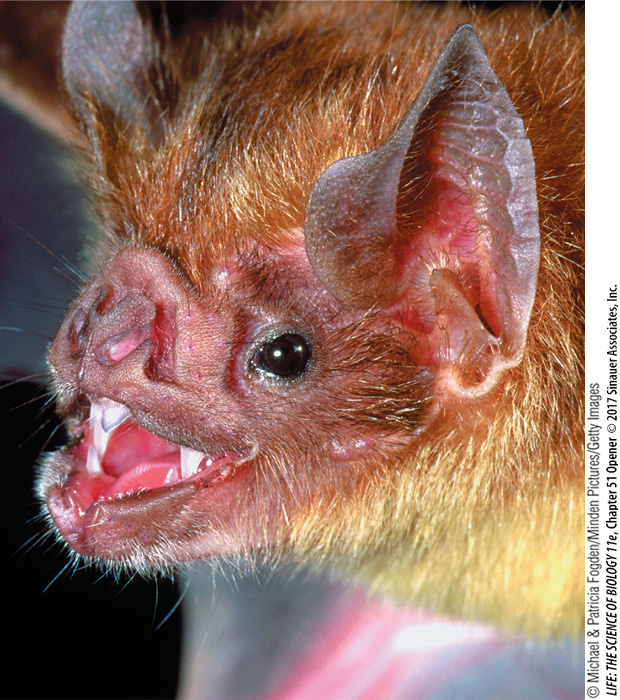Chapter Introduction
1093
51
key concepts
51.1
Excretory Systems Regulate Osmotic and Ionic Concentrations
51.2
Animals Excrete Nitrogen as Ammonia, Urea, or Uric Acid
51.3
Invertebrate Excretory Systems Use Filtration, Secretion, and Reabsorption
51.4
The Nephron Is the Basic Functional Unit of Vertebrate Excretory Systems
51.5
The Mammalian Kidney Can Produce Concentrated Urine
51.6
Kidney Function Is Regulated
Salt and Water
Balance and
Nitrogen Excretion

investigating life
How Vampire Bats Use Blood as Fast Food
Blood, sweat, and tears have the composition of extracellular fluid and taste salty. The composition and volume of the extracellular fluid are regulated by the excretory system. The challenges to an animal’s excretory system depend on its environment and lifestyle. Some desert animals rarely encounter free water, so they must conserve water by excreting their excess ions and nitrogenous wastes with as little water loss as possible. Animals living in fresh water have the opposite challenge: water continuously enters their bodies by osmosis and with their food, so they must excrete water and conserve ions. Vertebrate animals living in the ocean face a challenge similar to that of the desert dwellers; they lose body water by osmosis and therefore need to conserve water and excrete ions.
The physiological mechanisms animals have to maintain salt and water balance are similar, but they are used in different ways to solve the problems unique to each species. Consider vampire bats, which feed on the blood of animals such as goats and cattle. The bats use their sharp incisor teeth to make a small incision (usually on the ankle or leg of a sleeping victim) and then lap up the blood. A vampire bat feeds only once a day, and has to do so quickly, before the victim awakens and shakes it off.
Blood contains nutritious protein but consists mostly of water. To meet its daily energy needs, a vampire bat must take in a huge volume of blood relative to its body size, and it has to be able to fly back to its roost. To maximize protein intake and still be able to fly, the bat gets rid of water fast. The warm fluid flowing down the victim’s leg is not blood!
Back in the roost, the bat’s challenge is reversed. To digest a high-
How does the excretory system of vampire bats process their high-